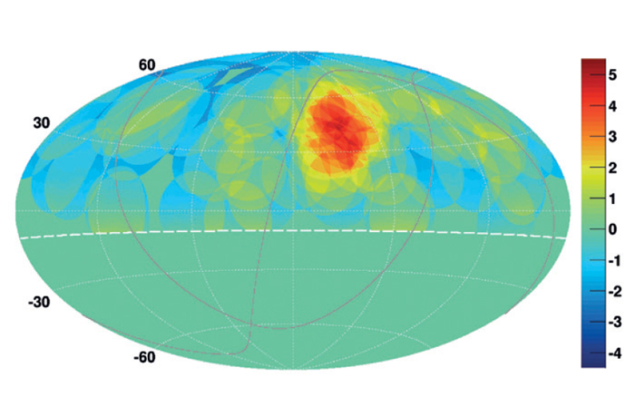
Image credit: K Kawata/University of Tokyo Institute for Cosmic Ray Research.
The distribution of ultra-high-energy cosmic rays (UHECR) recorded by the Telescope Array (TA) in the northern sky is displaying an intriguing “hotspot” in the direction of the Ursa Major constellation. The 19 events out of 72 with energies above 57 EeV (1 EeV = 1018 eV) clustering in a circle 40° in diameter represent a statistical excess of 5.1σ. The calculated probability of chance occurrence out of an isotropic distribution is only 3.7 in 10,000, but there is no obvious association with known sources in this field.
The origin of cosmic rays has intrigued physicists since their discovery in 1912. The difficulty is that, unlike light rays, these charged particles are deflected by the Galaxy’s magnetic field and their arrival direction is therefore randomized. It is only recently, through indirect methods, that the Fermi Gamma-ray Space Telescope was able to find evidence for cosmic rays being accelerated in supernova remnants (CERN Courier April 2013 p12 ).
UHECR – particles with energies above 1 EeV – are thought to be of different origin. Those with the highest energy (E > 60 EeV) are the least affected by magnetic fields and should roughly keep their original direction and point towards their emission source. They are also interesting because they cannot come from distances much further than 300-million light-years, because they would interact with the cosmic-microwave background to produce pions. In 2007 the collaboration behind the Pierre Auger Observatory (PAO) announced a correlation between the distribution in the southern sky of UHECRs and nearby active galactic nuclei (CERN Courier December 2007 p5). After the initial enthusiasm, however, additional data slightly weakened the significance of this result, rather than increasing it. Nevertheless, what is obvious is that the galactic plane is not the prime source of the UHECR. They must therefore originate from somewhere in the large-scale structures of the local universe.
A new study of the distribution of UHECR is now claiming a strongly anisotropic distribution with a large “hotspot” centred in the well-known constellation of Ursa Major. The study uses data obtained in the years 2008–2013 by the TA – the northern-sky analogue of the PAO. Covering an area of around 700 km2 in Utah, with 3 m2 scintillation detectors placed every 1.2 km on a square grid, the TA is currently the largest UHECR detector in the northern hemisphere. During the six-year study, only 72 events with energies above 57 EeV were detected. Assuming an uncertainty in the direction of 20° – a circle 40° wide is associated with each event – the researchers found a clustering of events, extending over roughly 40°, with a statistical excess of 5.1σ. To account for random clustering better, the collaboration simulated a million Monte Carlo data sets of 72 spatially random events in the field of view and obtained 365 instances of a clustering on different scales higher than the observed one. This corresponds to a chance probability of only 3.7 × 10–4, equivalent to a one-sided significance of 3.4σ.
The collaboration, with physicists mainly from the Universities of Tokyo and Utah, notes that there are no specific sources at the position of the excess. If the hotspot is real, it might be associated with the supergalactic plane, which contains local galaxy clusters such as the Ursa Major, Coma and Virgo clusters. This would imply a deflection by more than around 40° from this plane to the observed hotspot, which is too large an angle for protons and could indicate cosmic rays of rather heavy nuclei, which are deflected more by magnetic fields. The TAx4 project, an extension of the TA, would provide a speed-up of the detection rate to confirm the existence of the excess.





